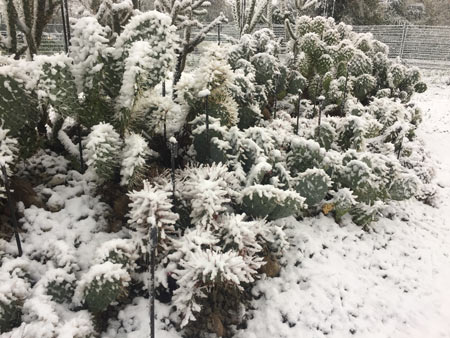Opuntia

Opuntia, of which the Mexican species Opuntia ficus-indica (the prickly pear) is well known in Italy, is a vast genus that comprehend species that are very resistant to the cold and others, more delicate, from the warmer and humid tropical regions.
| Etymology | Opuntia derives from the ancient Greek Opus, a city near Thebes. The name is referred to by Theophrastus to indicate a type of edible plant ever identified. |
|---|---|
| Type species | Opuntia humifusa Mill. |
| Synonimies | Marenopuntia, Backeb. |
| Natural origin | Opuntia plants species are common in the sub-arid and arid areas of the Americas. |
Some varieties of Opuntia have been introduced in Europe since the seventeenth century for their use as fodder and for the production of the fruit, the prickly pear. Or for breeding cochineal Dactylopius coccus, a parasitic insect from which the cochineal red pigment is extracted, very precious in antiquity.
Some species are extremely resistant to the cold, so they are used in the creation of rock gardens in climatic zones not suitable for the use of varieties of more delicate exotic ornamental plants. Thanks to the strong thorns, some varieties are also used as anti-intrusion barriers.
Description
The opuntia are distinguished by the growt 'by segments' or successive ramifications. From a main stem, secondary stems are produced and so on, until the formation of shrub or arboreal plants. The stem of the opuntias is flattened and oval, and tends to take on the appearance of a leaf blade. This particular form of stem is called cladodium. Another distinctive feature is the presence of microscopic spines (glochids) able to easily penetrate the skin, inflicting annoying itching or acute pain.
Taxonomy
Because of the ease of hybridisation in nature and the inconsistency of botanical descriptions of the genus Opuntia, the classification of the various species is sometimes difficult if not impossible. In this sense, the only solution consists in obtaining certified and safe material.
At one time, the genus Opuntia included several subgenera:
- Austrocylindropuntia
- Brasiliopuntia
- Corynopuntia
- Cylindropuntia
- Micropuntia
- miqueliopuntia
Currently these subgenres have been separated from Opuntia and raised to the genus rank.
 Our collection of opuntias exposed to the winter cold.
Our collection of opuntias exposed to the winter cold.Use
The cultivation of the prickly pear is an interesting solution for the production of dry and therefore unproductive soils for some regions of the south and the islands of Italy, either as forage or fruit, for which the white, yellow and red cultivars have been selected, both by the by-products of the processing of branches (cladodes) and seeds, from which useful principles in cosmetics and medicine are extract.
Needs
All the Opuntia require mineral soils, poor, free from water stagnation. They prefer sunny locations and tolerate saltiness.
In addition to the cold-resistant species (called 'frosty-hardy' from the Anglo-Saxons), there are many more delicate opuntia, with a very pleasant appearance whose cultivation is to be done in a pot, in order to be sheltered in places protected from excessive cold and humidity. in winter.
Adversity
The plants of Opuntia are particularly sensitive to the aggression of the cochineal Diaspis echinocacti. The fight is carried out with specific anti-cochineal products, avoiding the use of white oils, because they ruin the skin of the opuntia.
Curiosity
The opuntia are all equipped with tigmotropic anthers. The phenomenon, discovered by Charles Darwin, consists in the rapid movement of the anthers when they are rubbed: in this way the insects that are introduced into the flower in search of nectar are covered with pollen more effectively than flowers with static anthers.
